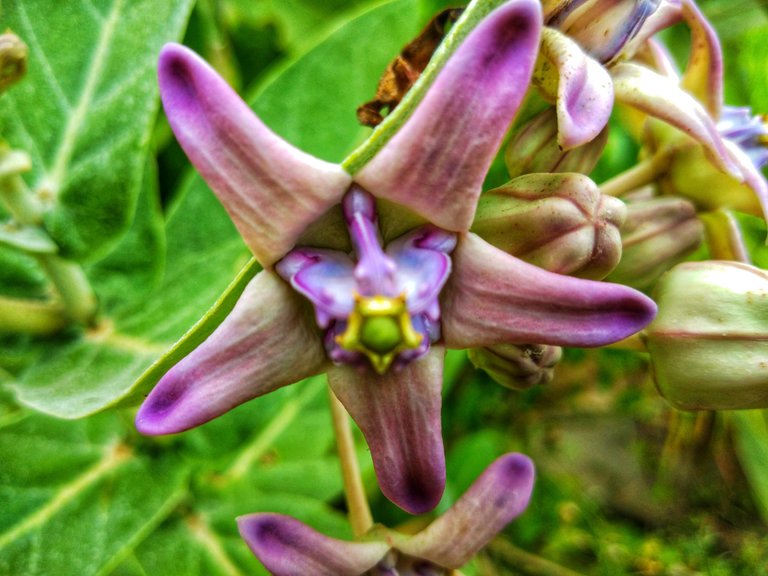BIDURI: the Neglected Multi-Efficacy Plant
Biduri plants, or thistles, are native to Indonesia. This plant is often found in coastal areas. Generally grow naturally, and so far are more often seen as weeds or nuisance plants. Rarely do people pay attention. Even if they happen to see it, people tend to see it at a glance because of its beautiful purple flowers.
 Biduri by @ihsan19
Biduri by @ihsan19
However, plants that are only underestimated in this country, have turned out to have important meanings in several countries. Hawaiians call the biduri an exotic flower, and it is mentioned in various references as the favorite flower of Queen Liliuokalani, the last monarch in Hawaii. The biduri flower in Hawaii is used for lei, a flower arrangement that is given to guests upon arrival or at the time of leaving as a sign of affection.
In India, this plant has become an important object of research for experts to explore its potential compound content as medicine, considering that this plant has long been used as herbal medicine.
Biduri flowers are used in various flower arrangements in Thailand because of their long-lasting nature. In Cambodia, biduri flowers are used in funeral ceremonies, to decorate coffins and decorations at funeral homes.
Biduri, quoting from Wikipedia, is a plant native to Indonesia, Cambodia, Malaysia, the Philippines, Thailand, Sri Lanka, India, China, Pakistan, Nepal, and tropical regions of Africa.
Its scientific name, Calotropis gigantea, (L.) W.T. Aiton (1811). In English, the plant is called the giant milkweed or crown flower. In Indonesia, this plant is also known by the names badori, saduri, sidoguri, and bataoan.
Biduri is a perennial plant, in the form of a large shrub that can reach 2-4 m in height. The stem is woody, cylindrical, dirty white in color, smooth surface, simpodial branching (main stem is not clearly visible), and secretes a milky white latex. Biduri has a riding root.
The leaves are single, arranged opposite, oval-shaped and blunt-tipped with rather thick leaves, whitish green, 8-20 cm long, 4-15 cm wide, smooth surface.
Compound flowers, umbrella-shaped, emerge from the leaf axillaries (axillaris), long-stemmed, green petals, slightly purplish white crown, waxy, crown length of approximately 4 mm.
The fruit is bulbous (folliculus), ovoid, green in color, oval in shape with seeds, small, brown in color.
These plants reproduce sexually (by seeds).
 Biduri by @ihsan19
Biduri by @ihsan19
Benefits and Efficacy of Biduri
Dr A Seno Sastroamidjojo in his book, Indonesian Original Medicine (1967), said that this plant contains mudarine (bitter substance), resin, alban, fluavil. Wikipedia mentions biduri sap contains cardiac glycosides, various acids, and calcium oxalate.
The leaves of this plant, according to Sastroamidjojo, have long been used as an itching and scabies remedy. The flowers are used traditionally as a medicine for asthma and intestinal pain. The sap is used as a medicine for ulcers and toothache medicine.
The Indian literature also mentions that biduri has long been used to treat common ailments such as fever, rheumatism, digestive disorders, coughs, colds, eczema, asthma, elephantiasis, nausea, vomiting, and diarrhea, as can be read on the website hort.purdue.edu.
The Ayurvedic medical tradition also mentions the dry matter of all parts of the plant as having tonic, expectorant, depurative, and anthelmintic properties. The root bark is a febrifuge, anthelmintic, depurative, expectorant, and laxative. Root powder is used in asthma, bronchitis, and dyspepsia. The leaves are useful in the treatment of paralysis, arthralgia, swelling, and intermittent fever. The flowers are bitter, used as a digestive remedy, anthelmintic, and tonic.
Apart from being medicinal, biduri is a long-lasting fiber-producing plant and is commercially processed in India for ropes, carpets, fishing nets and sewing thread. Yarn, obtained from seed fibers, is used for stuffing.
The fermented biduri mixed with salt is used to remove hair from goatskin in the process of tanning sheepskin for the manufacture of book binders.
However, almost the same as bintaro, biduri is also called a poisonous plant. The very thick sap of the leaves and stems, with the active ingredients uscharin, calotoxin, calactin, and calotropin, is traditionally used as poison in arrows. In some cases, the sap is also used as poison for animals.
Article Source by SATUHARAPAN.COM
I translated it back into English
Source of plagiarism
Direct translation without giving credit to the original author is Plagiarism. Repeated plagiarism is considered fraud. Fraud is discouraged by the community and may result in the account being Blacklisted.
Guide: Why and How People Abuse and Plagiarise
Please note that direct translations including attribution or source with no original content are considered spam.
If you believe this comment is in error, please contact us in #appeals in Discord.
in this post I believe I have written the source of the original article.